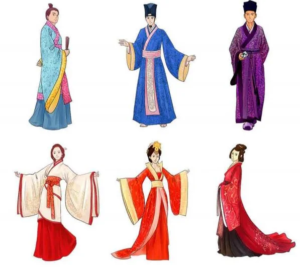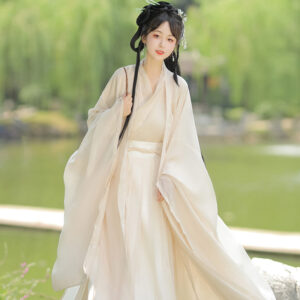

Distinguishing between Hanfu from various Chinese dynasties involves examining several key characteristics, including fabric, color, garment structure, and ornamental details unique to each dynasty. Here’s a detailed guide to help identify the distinct styles of Hanfu across different periods.
1. Han Dynasty (206 BC – 220 AD)
- Fabric and Material: Primarily silk and hemp were used. Silk became more prominent as sericulture advanced.
- Style and Cut: Hanfu featured cross-collar designs with a loose fit, allowing for ease of movement. The typical silhouette was straight and flowing.
- Symbolism and Color: Colors were generally monochromatic and subdued, reflecting simplicity and practicality.
- Notable Features: The Han Dynasty is characterized by cultural uniformity, with styles that emphasized functionality.
2. Tang Dynasty (618 – 907 AD)
- Fabric and Material: A mix of silk and linen was common, with luxurious brocades becoming popular.
- Style and Cut: Loose, flowing robes with wide sleeves were prevalent. The high-waisted Ruqun became a signature style for women.
- Symbolism and Color: Bright, varied colors symbolized the cosmopolitan nature of Tang society, embracing diversity.
- Notable Features: The Tang Dynasty was known for its extravagant styles that incorporated foreign influences due to trade along the Silk Road.
3. Song Dynasty (960 – 1279 AD)
- Fabric and Material: Lightweight silk and cotton were favored for comfort and practicality.
- Style and Cut: Simplified, modest cuts characterized Song Hanfu. Garments often featured narrower sleeves and less volume compared to previous dynasties.
- Symbolism and Color: Subdued colors reflected Confucian ideals of modesty and restraint.
- Notable Features: The focus on practicality in design mirrored the societal emphasis on Confucian values during this period.
4. Ming Dynasty (1368 – 1644 AD)
- Fabric and Material: Fine silk and brocade became dominant, with an emphasis on luxurious textures.
- Style and Cut: Elaborate, layered designs were common. The Aoqun, consisting of a jacket (Ao) paired with a skirt (Qun), was particularly popular among women.
- Symbolism and Color: Vibrant colors with intricate patterns celebrated traditional Han culture during a period of nationalistic revival.
- Notable Features: This era marked a resurgence of traditional aesthetics, moving away from foreign influences seen in earlier dynasties.
5. Qing Dynasty (1644 – 1912 AD)
- Fabric and Material: A mix of silk, cotton, and wool was utilized, reflecting the diverse resources of the empire.
- Style and Cut: Narrower sleeves with fitted cuts became standard due to Manchu influence. The Qipao or Cheongsam emerged as a popular style for women.
- Symbolism and Color: Imperial colors like yellow were used exclusively by the emperor; symbolic motifs were common in designs.
- Notable Features: Manchu influences led to significant changes in Hanfu styles, including the introduction of straight cuts and structured designs that contrasted with earlier flowing styles.
Summary Table: Key Characteristics of Hanfu Across Dynasties
| Dynasty | Fabric & Material | Style & Cut | Symbolism & Color | Notable Features |
|---|---|---|---|---|
| Han | Silk, hemp | Cross-collar, loose fit | Monochromatic, subdued colors | Cultural uniformity |
| Tang | Silk, linen | Loose, flowing robes | Bright, varied colors | Cosmopolitan influences |
| Song | Lightweight silk, cotton | Simplified, modest cut | Subdued colors reflecting modesty | Practicality reflecting Confucian ideals |
| Ming | Fine silk, brocade | Elaborate, layered | Vibrant colors, intricate patterns | Revival of Han nationalism |
| Qing | Silk, cotton, wool | Narrower sleeves, fitted cuts | Imperial colors, symbolic motifs | Manchu influences and diversity |
Conclusion
By examining these characteristics—fabric types, garment structures, color symbolism, and notable features—one can effectively distinguish between Hanfu styles from different dynasties. Each era reflects the cultural values and historical contexts that shaped its unique fashion identity. Understanding these distinctions not only enhances appreciation for traditional Chinese clothing but also provides insight into the broader socio-political landscape throughout Chinese history.
Share this post
Recent Posts


What were the key features of Hanfu during the Tang Dynasty?

How did Hanfu styles vary during different Chinese dynasties?

What accessories are typically worn with Hanfu?

How do you choose the right Hanfu for different seasons?

Newsletter
Popular Categories
Related Post
Sed aliquam, tortor et sodales malesuada, lorem leo luctus tellus, quis interdum eros nibh in nunc. Cras dignissim malesuada, lorem leo luctus

What are the winter hanfu called?

What were the key features of Hanfu during the Tang Dynasty?

How did Hanfu styles vary during different Chinese dynasties?


